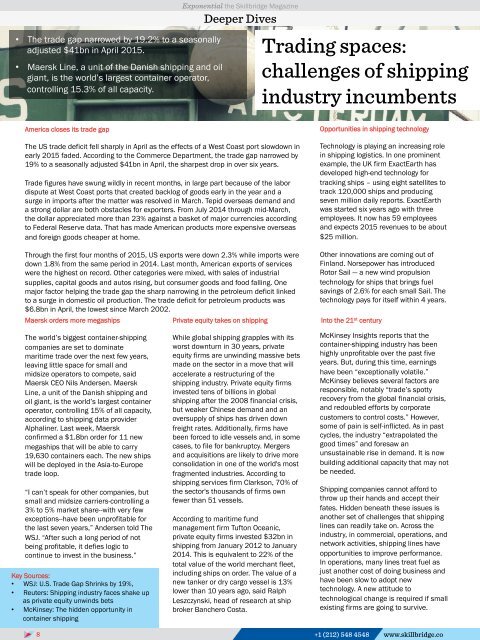Exponential -- June 14, 2015
In this issue, we discuss the global war for talent and the freelance platforms that are driving this talent revolution, South Korea's rapidly growing startup scene, the decline of the postal service, and why shipping firms must continue to innovate. We also feature an exclusive interview with Deb Cupp, SVP and General Manager for HR at SAP, who discusses how human resources solutions can be more seamlessly integrated into companies.
In this issue, we discuss the global war for talent and the freelance platforms that are driving this talent revolution, South Korea's rapidly growing startup scene, the decline of the postal service, and why shipping firms must continue to innovate. We also feature an exclusive interview with Deb Cupp, SVP and General Manager for HR at SAP, who discusses how human resources solutions can be more seamlessly integrated into companies.
Create successful ePaper yourself
Turn your PDF publications into a flip-book with our unique Google optimized e-Paper software.
• The trade gap narrowed by 19.2% to a seasonally<br />
adjusted $41bn in April <strong>2015</strong>.<br />
• Maersk Line, a unit of the Danish shipping and oil<br />
giant, is the world’s largest container operator,<br />
controlling 15.3% of all capacity.<br />
<strong>Exponential</strong> the Skillbridge Magazine<br />
Deeper Dives<br />
Trading spaces:<br />
challenges of shipping<br />
industry incumbents<br />
America closes its trade gap<br />
The US trade deficit fell sharply in April as the effects of a West Coast port slowdown in<br />
early <strong>2015</strong> faded. According to the Commerce Department, the trade gap narrowed by<br />
19% to a seasonally adjusted $41bn in April, the sharpest drop in over six years.<br />
Trade figures have swung wildly in recent months, in large part because of the labor<br />
dispute at West Coast ports that created backlog of goods early in the year and a<br />
surge in imports after the matter was resolved in March. Tepid overseas demand and<br />
a strong dollar are both obstacles for exporters. From July 20<strong>14</strong> through mid-March,<br />
the dollar appreciated more than 23% against a basket of major currencies according<br />
to Federal Reserve data. That has made American products more expensive overseas<br />
and foreign goods cheaper at home.<br />
Through the first four months of <strong>2015</strong>, US exports were down 2.3% while imports were<br />
down 1.8% from the same period in 20<strong>14</strong>. Last month, American exports of services<br />
were the highest on record. Other categories were mixed, with sales of industrial<br />
supplies, capital goods and autos rising, but consumer goods and food falling. One<br />
major factor helping the trade gap the sharp narrowing in the petroleum deficit linked<br />
to a surge in domestic oil production. The trade deficit for petroleum products was<br />
$6.8bn in April, the lowest since March 2002.<br />
Maersk orders more megaships<br />
Private equity takes on shipping<br />
Opportunities in shipping technology<br />
Technology is playing an increasing role<br />
in shipping logistics. In one prominent<br />
example, the UK firm ExactEarth has<br />
developed high-end technology for<br />
tracking ships – using eight satellites to<br />
track 120,000 ships and producing<br />
seven million daily reports. ExactEarth<br />
was started six years ago with three<br />
employees. It now has 59 employees<br />
and expects <strong>2015</strong> revenues to be about<br />
$25 million.<br />
Other innovations are coming out of<br />
Finland. Norsepower has introduced<br />
Rotor Sail — a new wind propulsion<br />
technology for ships that brings fuel<br />
savings of 2.6% for each small Sail. The<br />
technology pays for itself within 4 years.<br />
Into the 21 st century<br />
The world’s biggest container-shipping<br />
companies are set to dominate<br />
maritime trade over the next few years,<br />
leaving little space for small and<br />
midsize operators to compete, said<br />
Maersk CEO Nils Andersen. Maersk<br />
Line, a unit of the Danish shipping and<br />
oil giant, is the world’s largest container<br />
operator, controlling 15% of all capacity,<br />
according to shipping data provider<br />
Alphaliner. Last week, Maersk<br />
confirmed a $1.8bn order for 11 new<br />
megaships that will be able to carry<br />
19,630 containers each. The new ships<br />
will be deployed in the Asia-to-Europe<br />
trade loop.<br />
“I can’t speak for other companies, but<br />
small and midsize carriers-controlling a<br />
3% to 5% market share--with very few<br />
exceptions--have been unprofitable for<br />
the last seven years,” Andersen told The<br />
WSJ. “After such a long period of not<br />
being profitable, it defies logic to<br />
continue to invest in the business.”<br />
Key Sources:<br />
• WSJ: U.S. Trade Gap Shrinks by 19%,<br />
• Reuters: Shipping industry faces shake up<br />
as private equity unwinds bets<br />
• McKinsey: The hidden opportunity in<br />
container shipping<br />
While global shipping grapples with its<br />
worst downturn in 30 years, private<br />
equity firms are unwinding massive bets<br />
made on the sector in a move that will<br />
accelerate a restructuring of the<br />
shipping industry. Private equity firms<br />
invested tens of billions in global<br />
shipping after the 2008 financial crisis,<br />
but weaker Chinese demand and an<br />
oversupply of ships has driven down<br />
freight rates. Additionally, firms have<br />
been forced to idle vessels and, in some<br />
cases, to file for bankruptcy. Mergers<br />
and acquisitions are likely to drive more<br />
consolidation in one of the world's most<br />
fragmented industries. According to<br />
shipping services firm Clarkson, 70% of<br />
the sector's thousands of firms own<br />
fewer than 51 vessels.<br />
According to maritime fund<br />
management firm Tufton Oceanic,<br />
private equity firms invested $32bn in<br />
shipping from January 2012 to January<br />
20<strong>14</strong>. This is equivalent to 22% of the<br />
total value of the world merchant fleet,<br />
including ships on order. The value of a<br />
new tanker or dry cargo vessel is 13%<br />
lower than 10 years ago, said Ralph<br />
Leszczynski, head of research at ship<br />
broker Banchero Costa.<br />
McKinsey Insights reports that the<br />
container-shipping industry has been<br />
highly unprofitable over the past five<br />
years. But, during this time, earnings<br />
have been “exceptionally volatile.”<br />
McKinsey believes several factors are<br />
responsible, notably “trade’s spotty<br />
recovery from the global financial crisis,<br />
and redoubled efforts by corporate<br />
customers to control costs.” However,<br />
some of pain is self-inflicted. As in past<br />
cycles, the industry “extrapolated the<br />
good times” and foresaw an<br />
unsustainable rise in demand. It is now<br />
building additional capacity that may not<br />
be needed.<br />
Shipping companies cannot afford to<br />
throw up their hands and accept their<br />
fates. Hidden beneath these issues is<br />
another set of challenges that shipping<br />
lines can readily take on. Across the<br />
industry, in commercial, operations, and<br />
network activities, shipping lines have<br />
opportunities to improve performance.<br />
In operations, many lines treat fuel as<br />
just another cost of doing business and<br />
have been slow to adopt new<br />
technology. A new attitude to<br />
technological change is required if small<br />
existing firms are going to survive.<br />
8 +1 (212) 548 4548 www.skillbridge.co











